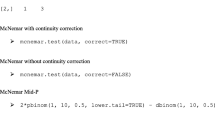Abstract
The inability to identify fragile sites from data for single individuals remains the major obstacle to determining whether these chromosomal loci are predisposed to cancer-causing and evolutionary rearrangements. We describe a novel statistical model that is amenable to data from single individuals and that establishes site-specific chromosomal breakage as nonrandom with respect to the distribution of total breakage. Our method tests incrementally smaller subsets of the data for homogeneity under a multinomial model that assigns equal probabilites to a maximal set of nonfragile sites and unrestricted probabilities to the remaining fragile sites with significantly higher numbers of breaks. We show how standardized Pearson's chi-square (X 2) and likelihood-ratio (G 2) statistics can be appropriately used to measure goodness-of-fit for sparse contingency (individual-based) data in this model. A sample application of this approach indicates extensive variation in fragile sites among individuals and marked differences in fragile-site inferences from pooled as opposed to per-individual data.
Similar content being viewed by others
References
Agresti A (1990) Analysis of categorical data. Wiley, New York
Berger R, Bloomfield CD, Sutherland GR (1985) Report of the committee on chromosome rearrangements in neoplasia and on fragile sites. (8th International Workshop on Human Gene Mapping) Cytogenet Cell Genet 40:490–535
Dahm PF, Greenbaum IF (1994) Reconsideration of the binomial and F distribution relationship as a test of nonrandomness of chromosomal breakage. Cytogenet Cell Genet 66:214–215
De Braekeleer M (1987) Fragile sites and chromosomal structural rearrangements in human leukemia and cancer. Anticancer Res 7:417–422
De Braekeleer M (1989) Fragile sites and statistics. Hum Genet 84:103
De Braekeleer M, Smith B (1988) Two methods for measuring non-randomness of chromosome abnormalities. Ann Hum Genet 52:63–67
De Braekeleer M, Smith B, Lin CC (1985) Fragiles sites and structural rearrangements in cancer. Hum Genet 69:112–116
Feller W (1971) An introduction to probability theory and its applications. Wiley, New York
Greenbaum IF, Gunn SJ, Smith SA, McAllister BF, Hale DW, Baker RJ, Engstrom MD, Hamilton MJ, Modi WS, Robbins LW, Rogers DS, Ward OG, Dawson WD, Elder FFB, Lee MR, Pathak S, Stangl FB Jr (1994) Cytogenetic nomenclature of deer mice, Peromyscus (Rodentia): revision and review of the standardized karyotype. Cytogenet Cell Genet 66:181–195
Hecht F (1986) Rare, polymorphic and common fragile sites: a classification. Hum Genet 74:207–208
Hecht F, Glover TW (1984) Cancer chromosome breakpoints and common fragile sites induced by aphidicolin. Cancer Genet Cytogenet 13:185–188
Hecht F, Sutherland GR (1984) Fragile sites and cancer breakpoints. Cancer Genet Cytogenet 12:179–181
Holmquist GP (1992) Chromosome bands, their chromatin flavors, and their functional features. Am J Hum Genet 51:17–37
Jordan DK, Burns TL, Divelbiss JE, Woolson RF, Patil SR (1990) Variability in expression of common fragile sites: in search of a new criterion. Hum Genet 85:462–466
Kao-Shan CS, Fine RL, Whang-Peng J, Lee EC, Chabner BA (1987) Increased fragile sites and sister chromatid exchanges in bone marrow and peripheral blood of young cigarette smokers. Cancer Genet Cytogenet 33:1–9
Koehler J (1986) Goodness of fit tests for log-linear models in sparse contingency tables. J Am Statist Assoc 81:483–493
Koehler J, Larntz K (1980) An empirical investigation of goodness of fit statistics for sparse multinomials. J Am Stat Assoc 75:336–344
Le Beau MM (1986) Chromosomal fragiles sites and cancer-specific rearrangements. Blood 67:849–858
Le Beau MM, Rowley JD (1984) Heritable fragile sites and cancer. Nature 308:607–608
Mariani T (1989a) Fragile sites and statistics. Hum Genet 81:319–322
Mariani T (1989b) Reply to letter by M. De Braekeleer. Hum Genet 84:104
Miro R, Clemente IC, Fuster C, Egozcue J (1987) Fragile sites, chromosome evolution and human neoplasia. Hum Genet 75: 345–349
Morris CL (1975) Central limit theorem for multinomial sums. Ann Stat 3:165–188
Porfirio B, Dallapiccola B, Terrenato L (1987) Breakpoint distribution in constitutional chromosome rearrangements with respect to fragile sites. Ann Hum Genet 51:329–336
Robinson TJ, Elder FFB (1987) Multiple common fragile sites are expressed in the genome of the laboratory rat. Chromosoma 96:45–49
Seber GA (1977) Linear regression analysis. Wiley, New York
Smeets DFCM, Klundert FAJM van de (1990) Common fragile sites in man and three closely related primate species. Cytogenet Cell Genet 53:8–14
Smeets D, Verhagen A, Hustinx T (1989) Familial and individual variation in chromosome fragility. Mutat Res 212:223–229
Smith CAB (1986) Chi-squared tests with small numbers. Ann Hum Genet 50:163–167
Sugio Y, Kuroki Y (1989) Family study of common fragile sites. Hum Genet 82: 191–193
Sumner AT (1972) A simple technique for demonstrating centromeric heterochromatin. Exp Cell Res 75:304–306
Sutherland GR, Hecht F (1985) Fragile sites on human chromosomes. Oxford University Press, New York
Tai JJ, Hou C-D, Wang-Wuu S, Wang C-H, Leu S-Y, Wuu K-D (1993) A method for testing the nonrandomness of chromosomal breakpoints. Cytogenet Cell Genet 63:147–150
Tarone RE (1989) Testing for non-randomness of events in sparse data situations. Ann Hum Genet 53:381–387
Vasarhelyi K, Friedman JM (1989) Analysing rearrangement breakpoint distributions by means of binomial confidence intervals. Ann Hum Genet 53:375–380
Verma RS, Babu A (1989) Human chromosomes: manual of basic techniques. Pergamon Press, New York
Yunis JJ (1983) The chromosomal basis of human neoplasia. Science 221:227–236
Yunis JJ (1984) Fragile sites and predisposition to leukemia and lymphoma. Cancer Genet Cytogenet 12:85–88
Yunis JJ, Soreng AI (1984) Constitutive fragile sites and cancer. Science 226:1199–1204
Author information
Authors and Affiliations
Rights and permissions
About this article
Cite this article
Böhm, U., Dahm, P.F., McAllister, B.F. et al. Identifying chromosomal fragile sites from individuals: a multinomial statistical model. Hum Genet 95, 249–256 (1995). https://doi.org/10.1007/BF00225189
Received:
Revised:
Issue Date:
DOI: https://doi.org/10.1007/BF00225189




